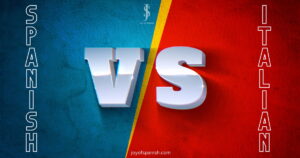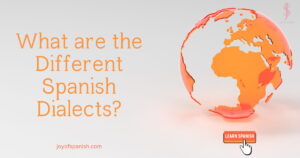Do you want to know how well you write, speak, listen, and read the Spanish language? As a Spanish learner, who wouldn’t?
This will help you identify your current ability and how much effort you need to put in for further improvement. As a result, you may be interested in taking one of the Spanish proficiency tests.
But with so many Spanish language tests, which one to take? DELE, Telc, SIELE, CELA, CELU, DIE, ECL, or something else?
It’s a complex task to pick a particular one.
Despite so many good options, DELE and SIELE are the most well-known for many apparent reasons. These two are often among the top choices for measuring Spanish skills.
But how can you decide which one to take? What are the similarities and differences between these two exams? What unique features, benefits, and disadvantages do they offer?
Everyone has a different motivation for learning Spanish and taking the test. So, it’s vital to consider several key points before signing up. This complete guide will provide all the answers you wish to know.
So, let’s begin!
Table of Contents
What are DELE and SIELE?
DELE is an acronym for Diplomas de Español Como Lengua Extranjera. On the other hand, SIELE stands for Servicio Internacional de Evaluación de la Lengua Española.
Both are internationally acknowledged tests that assess your proficiency in Spanish. It allows you to show how good you are in Spanish for various purposes.
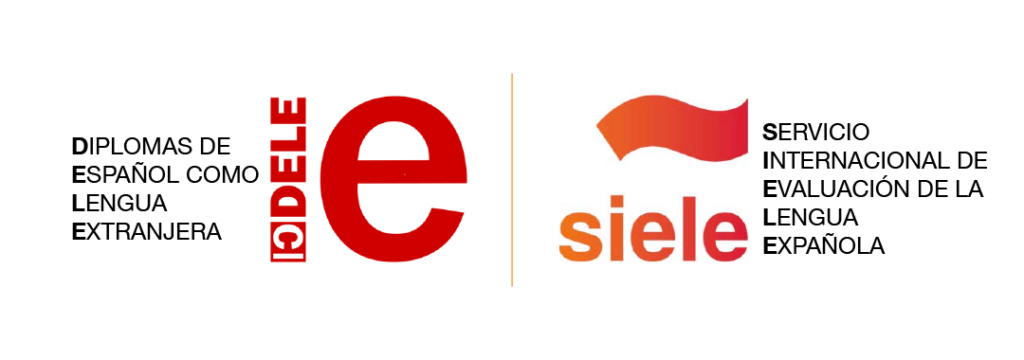
This can help you become a fluent or skilled speaker of Spanish. Both also attest to your Spanish expertise for different levels and skill sets.
Many universities in Spain and Central and South America need a diploma in either exam. If you work for Spanish companies or your firm deals with Spanish-speaking regions, that’s an incentive.
International Spanish tests include CELU, TELC, CELA, DIE (Diploma Internacional de Español), and ECL. These exams are not as popular or in demand as DELE or SIELE.
Who Conducts DELE and SIELE?
Instituto Cervantes, a renowned non-profit organization, manages the DELE test globally. It represents the Spanish government’s Ministry of Education, Culture, and Sports.
The University of Salamanca in Spain developed DELE. Correcting the test and evaluating the result falls under their responsibilities as well.
The Instituto Cervantes, the University of Buenos Aires, the University of Salamanca, and the National Autonomous University of Mexico promote SIELE. They facilitate, manage, and certify this exam.
The Seal of Biliteracy, ACLES, CRUE, and CNCP all recognize it.
For SIELE registration, visit the website and complete the signup process online. This is available all year round.
Similarities between DELE and SIELE
There are many parallels between the two systems for evaluating Spanish language skills.
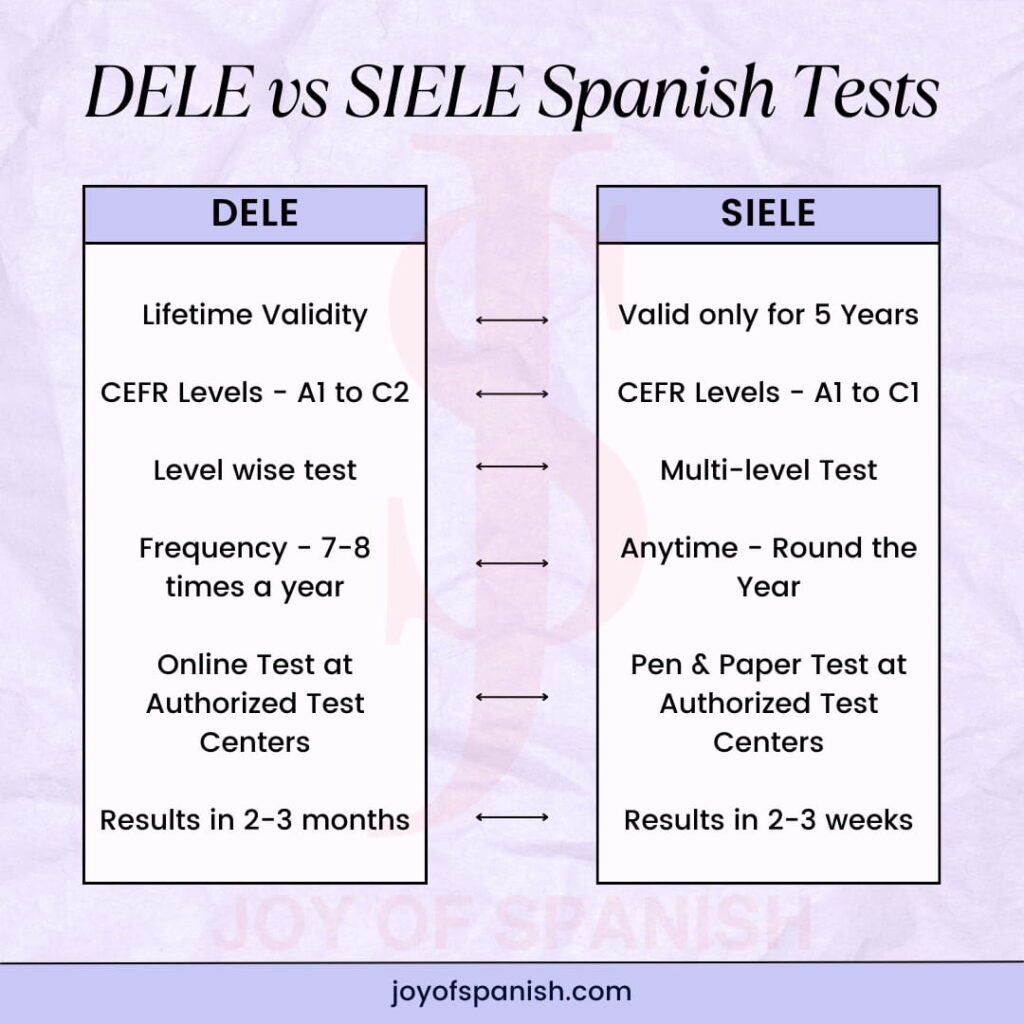
1. Recognition and Importance
DELE and SIELE are internationally recognized. Most educational institutions, employers, and governments in Spanish-speaking regions widely accept both tests.
While they share the same official status, the selection depends on your needs, intent, and preferences. Both provide a valuable certification of your Spanish language proficiency.
The DELE test started in 1989 and has become the most globally admitted Spanish test. Today, it is the first and most favored choice for Spanish learners. Lifetime validity gives an advantage over SIELE.
SIELE is also quickly catching up with its online exam. The number of test-takers is growing and is predicted to increase further.
Both tests help you earn a reputed diploma in Spanish accepted globally. You can use it for an array of purposes.
Overall, both are hugely popular and widely known across the world. No matter your choice, you won’t regret it since both tests are standard and accepted everywhere.
2. Both Spanish tests are beneficial
SIELE and DELE check your ability to use Spanish in real-life situations. It includes a variety of topics, subjects, conditions, and settings.
Test scores can prove competence when applying for jobs or pursuing higher education in Hispanic countries.
Institutions and businesses in Europe and Latin America highly value these diplomas as crucial eligibility criteria and qualifications.
Passing these exams can boost your career scope in many Spanish-speaking locations globally.
You can measure and improve your Spanish skills by taking one of the two tests available. This will also help you gain confidence. It also increases your chances of immigrating to places with many Spanish speakers.
3. They follow the CEFR model
SIELE and DELE share striking likenesses. Both of them conform to the guidelines specified by the CEFR (Common European Framework of Reference for Languages).
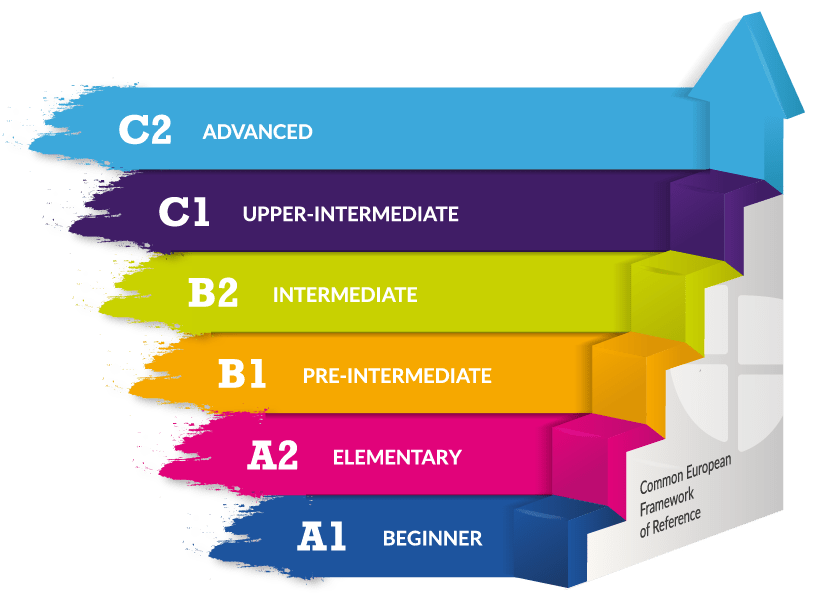
Both exams are aligned with the six levels of the CEFR.
The DELE comprises six levels: A1 (Basic: Breakthrough), A2 (Waystage), B1 (Threshold), and B2 (Vantage). The advanced has C1 (Advanced — Effective Operational Proficiency) and C2 (Mastery).
Unlike DELE, SIELE has only 5 levels and goes up to C1. There is no C2 in SIELE.
DELE’s four elements are like SIELE’s: writing, speaking, reading, and listening.
Compared to other European language tests, it is clearly valuable.
4. Similar Exam Preparation
DELE and SIELE use comparable questions for testing. The difficulty of the level, format, and questions are almost identical.
If you know your current Spanish level and your position in it. You can choose between the DELE and SIELE independent modalities (S1 to S5) and the SIELE Global.
You can conveniently prepare for both exams with audio lessons and exercise books. Also, you can use DELE resources for SIELE and vice versa.
You can access the SIELE demo, samples, practice, mockups, and old question papers on various sites, including the official one.
You can register for Spanish programs at the LanguageNext learning center. We also offer online Spanish lessons designed for the DELE and SIELE exams.
7 Top Differences between DELE and SIELE
Although they share certain similarities, many notable differences set them apart. Each of these International Spanish tests has its own set of pros and cons.
Let’s take a closer look at everything.
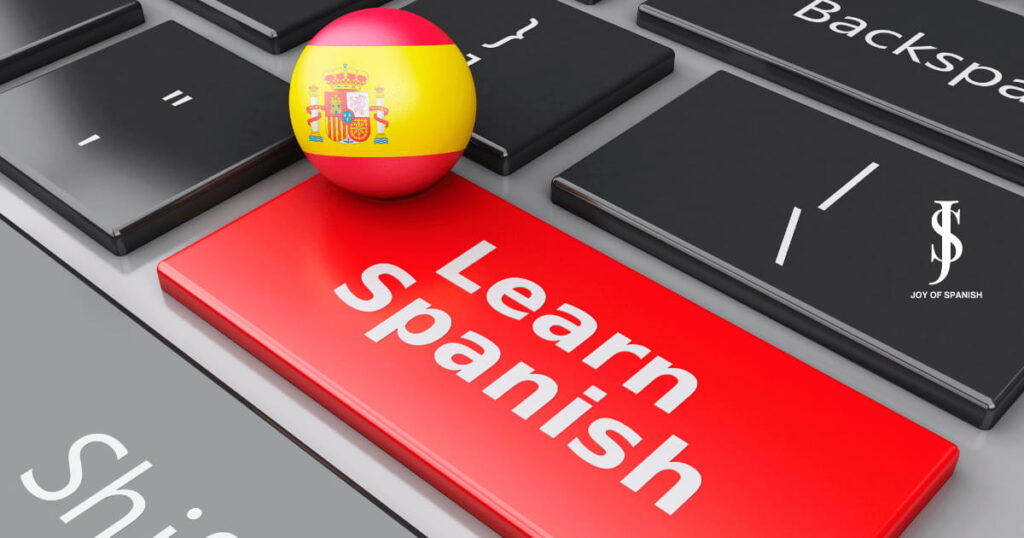
1. What is the validity of SIELE and DELE diplomas?
A vital difference between the DELE and SIELE certifications is their validity period.
A SIELE diploma grants you a five-year validity of your Spanish ability. It’s generally thought that it will decline if you don’t use your language skills. Thus, they expect you to prove your skills again after 5 years.
DELE remains valid for a lifetime, and scores never expire. You won’t have to retake the test to prove your Spanish proficiency. That’s a big help.
DELE is the perfect choice if you want to study Spanish for career advancement.
2. Time needed to gain results and certifications
With a DELE diploma award, the Spanish government and concerned bodies will admit to your Spanish language learning efforts.
Those who took the DELE exam must wait two to three months for their certification and scores. It takes a while for the results to reach your mailbox.
If you plan to get certified in Spanish quickly, there are better choices than DELE.
You can consider the SIELE test for fast certification in that case. The results and scores will be available to you in three weeks. It’s even possible to receive it within a week in some regions.

3. Eligibility for the exam
The SIELE or DELE exam is open to anyone, regardless of their mother tongue. It serves as a comprehensive assessment of their Spanish-speaking skills.
Candidates must be at least 16 years old to take the DELE exam. The SIELE exam allows students as young as 13 to take part.
SIELE evaluates candidates up to level C1. The language proficiency level does not include C2, which means near-native fluency. On the opposite, DELE assesses your proficiency in Spanish on a scale from A1 to C2.
Children between 11 and 17 can take a separate DELE exam for young learners. The test only has two levels: A1 and A2/B1.
4. Examination Dates
In 2024, DELE will occur on 16th February, 12th April, 17th and 18th May, 12th July, 13th September, 18th October, and 22nd and 23rd November.
They administer the test on all dates in India except September.
Official centers often offer the SIELE exam every month. This makes it more desirable for many people.
The date of the individual test will differ depending on the center. Select a date and time that suits you the best.
5. Test Centers worldwide
DELE exam centers are available in over 100 countries globally.
The dates may vary depending on your area. Thus, look for the nearest DELE center to your location.
The Instituto Cervantes administers the DELE exams independently or in partnership with other institutions. They conduct tests in six Indian cities: Anantapur, Chennai, Jaipur, Mumbai, Kolkata, and New Delhi.
SIELE is affiliated with over 80 universities in 20 countries in Central and South America.
You can pick from 1,000 testing centers in 85 countries worldwide to take the SIELE exam. India also has an impressive network of 22 SIELE testing centers.
6. DELE Vs. SIELE — The Modules and Structure
SIELE comprises four distinct modules. Here are:
- Reading Comprehension (RC): 60 minutes.
- Listening Comprehension (LC): 55 minutes.
- Written Expression and Interaction (WEI): 50 minutes.
- Spoken Expression and Interaction (SEI): 15 to 20 minutes.
You can mix and match modules to decide which ones are worth testing on an exam day. There is also a 15-minute break between the WEI and SEI tests.
Another possibility available to you is SIELE Global. You have three hours to complete all four modules.
The DELE examination has four modules: writing, speaking, reading, and listening. But, the duration can vary, and finishing all the tests in one day is mandatory.
Unlike SIELE, a multi-level test with DELE, you can choose the level you want to challenge yourself. Still, you can skip levels and appear for higher ones multiple times with no limit.
You need at least 60 marks to pass the DELE test.

Also, they allocate 30 marks to each of the two sections: Listening Comprehension and Oral Expression and Interaction. And written expression and interaction, and reading comprehension.
7. Exam Procedure
You can only take DELE at a designated classroom or exam center.
The test consists of written, listening, and speaking sections. Only a few exam schedules and intervals exist every year.
DELE test centers are few and far between across the globe. If no testing center is available in your area, you won’t be able to take the test. You may also not use the few available dates when needed.
In the above situation, SIELE is the optimal preference. It offers a great flexibility and convenience.
DELE and SIELE differ in one more aspect.
One person follows a traditional approach using pen and paper. Others can adopt the modern comfort of going online.
With its comprehensive Spanish online test, SIELE is an incredible option for many individuals. You can take it to a testing center anytime.
Remember to register for the exam at least 48 hours in advance.
After completing your registration, you can select a convenient date. And also an easily accessible SIELE center for your exam.
To take the DELE test, contact the Cervantes or their affiliated centers in your local area. You can find the DELE exam date, pay the fee, and wait for it.
Why is DELE better than SIELE?
DELE is more extensive in scope. The exceptional worth of this test extends to academic institutions, companies, and universities. So, DELE usually gets an edge over SIELE.
You can enhance your CV by obtaining the DELE diploma. Also, this qualification will empower you to showcase your Spanish proficiency throughout your life.
Besides that, the DELE also grants credentials for Spanish proficiency exams up to level C2. These diplomas are valid indefinitely, as they have no expiration date.
SIELE offers comparable advantages, although its validity is only for five years. Plus, SIELE doesn’t provide a C2 level that is near-native.
SIELE, which started in 2016, is a relatively new program. So, not all organizations worldwide take it as a confirmation of Spanish expertise. Things might improve going forward.
Why is SIELE better than DELE?
The SIELE test is available conveniently year-round. Besides, there’s no obligation to take any specific level.
The SIELE exam is based on a one-size-fits-all, flexible, quick, and fail-safe model. You can select modules and earn a maximum of 1000 points.
Since this is a single multi-level test without fail or pass, you will always get a score and level. So, success is always within reach. This is like language proficiency exams such as TOEFL or IELTS.
You can get the certification once you pass any DELE modules from A1, A2, B1, B2, C1, and C2.
DELE mainly focuses on the European or Standard Spanish of Spain. This is primarily at the beginners and intermediate levels from A1 to B1.
SIELE test includes all the dialects and Spanish linguistic varieties to assess students’ language talents. It covers the Spanish of Latin America, i.e., Español de América Latina.
Final Thoughts: SIELE Vs. DELE — Which Is Better?

Choosing between these two types of Spanish exams is difficult, as you can see.
DELE’s lifetime certification is undeniably its ultimate reward, despite its inflexibility.
SIELE is more flexible, providing convenience that DELE does not have. There are alternative methods to assess fluency that are more effective. But it is still good enough.
While SIELE and DELE share similarities, consider their differences and distinct features. These may include format, content, fees, dates, test centers, scoring, and recognition in particular regions or institutions.
The choice depends on your goals, personal preference, and where to use the certification. Carefully consider each option’s benefits and drawbacks before picking the one that suits you best.
Write your comment below if you have questions about Spanish DELE Vs. SIELE.


